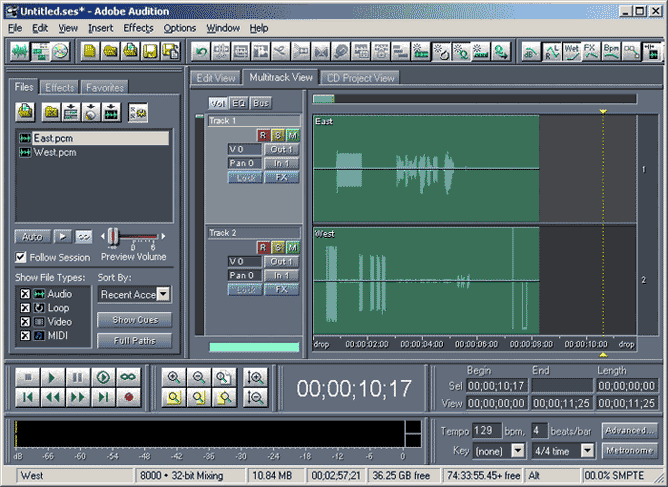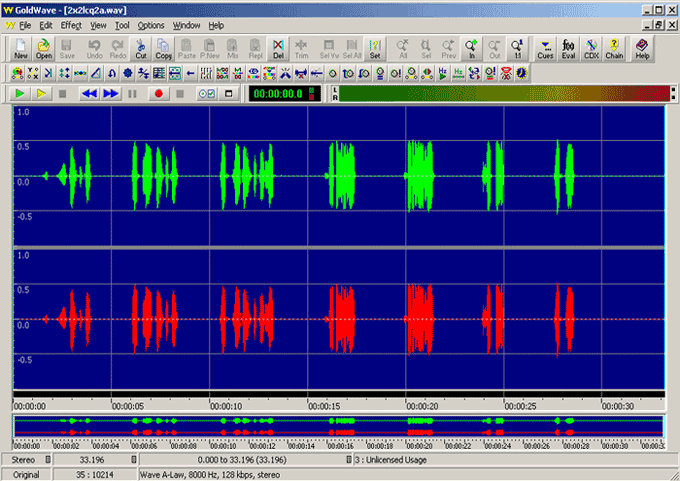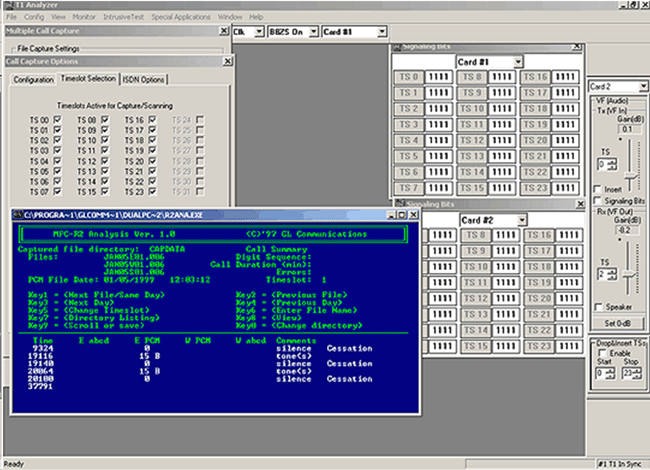T1 E1 Multiple Call Capture & Analysis Software
The Multi CCA allows users to log captured events in CSV or binary files and feed these results into GL’s Call Data Records (CDR) application to provide an overall summary of the call as well as the event-by-event account of each call.
Brochure Request a Demo / QuoteMulti Call Capture and Analysis
Multi CCA is used to monitor hundreds of calls, capture the bidirectional data, signaling and traffic, simultaneously from multiple T1 E1 lines, based on the user-defined trigger configurations. Once the capture trigger type is selected, users can control and run multiple capture instances on different T1 E1 ports from a single GUI.
Call capturing can be triggered from both directions (east and west) simultaneously using the user-defined trigger feature. The captured data will be stored into the *.pcm files. Call summary and other call details can also be logged into different files based on the user configurations. The application also indicates the channels on which a recording is taking place and the files names to which data is being stored. A message area provides status of the capture process.The Multi CCA allows users to log captured events in CSV or binary files and feed these results into GL’s Call Data Records (CDR) application to provide an overall summary of the call as well as the event-by-event account of each call.
The Multi CCA software can also work in conjunction with the CMU (Call Management Utility), to automatically identify captured calls and calls being captured.
Call capture based on the detection of some triggers or it can be manual capture. Different triggers supported by Multi CCA application are:
- Signaling based triggers - CAS -R1, wink start, MFC-R2
- ISDN and SS7 message based triggers
- Traffic activated triggers
- Voice based on a minimum power level
- Tones of specified frequency - Ring back tone, Dial tone, Busy tone, and DTMF digits
- Fax traffic - V.32 / V.17, V.27, V.29,
- Modem traffic - V.22 forward/reverse channel, V.34 & V.90 uplink, Binary V.90 downlink, FSK
- Any type of signal based on any power level
Subsequently, captured calls can be played back and analyzed in time and spectral modes using a commercial sound card, built-in high fidelity speakers, and audio viewing software (Adobe Audition, Goldwave).
Main Features
- Run multiple capture instances on different T1 E1 ports from a single GUI
- Capture calls directly from the T1 E1 lines using Automatic or Manual modes of call recording
- Captures can be triggered from both directions (east and west) simultaneously
- Captures can be triggered on a single direction, East or West side in a dual card system
- Ability to auto capture calls using different Triggering modes; both signaling (CAS -R1, wink start, MFC-R2), message based (ISDN, SS7) & traffic (voice, fax, modem, tones, digits…) activated triggers supported
- ISDN calls are recorded with CRV, ISDN message type, channel, direction, called and calling numbers. ISDN calls can be captured with customized called or calling number filter
- Detect and capture SS7 calls by defining DPC, OPC and CIC groups. SS7 calls can also be captured with customized called or calling number filter
- The digit-parsing feature of Multi CCA application helps user to distinguish CAS R1 or MFC-R2 calls by prefixing called and calling numbers to the filename
- Different encoding formats supported, including automatic conversion of u-law and A-law PCM files to WAV file format if required
- ‘Call filtering’ feature is used to capture calls with a user-defined called and calling numbers rather than all calls
- Each capture instance is identified by a unique probe name, and can have different capture options, such as the timeslot selection, output directory, recording time, and so on
- Various ”File Naming” conventions are used based on the type of capture. The file naming conventions suit various types of capture applications such as MFC-R2, signaling, ISDN capture, manual capture etc
- Provides an option of stamping the captured files sequentially or with date/time
- All call data are captured including signaling bits, voiceband data, signaling protocol data (e.g. DTMF or MF digits), and various types of traffic such as fax, modem, & voice
- Results from Multi CCA include -
- voice capture for both directions
- complete signaling information for each direction for CAS, ISDN, MFC-R2, and SS7
- all alarms and errors occurring during the call including BPV, Frame Errors, CRC errors, LOS, and more
- Captured PCM data is saved as two synchronized disk files (east and west directions) for post processing
- A separate signaling file for E1 and T1 is created
- Displays signaling bits for all channels in both directions, and each Time Slot status as Capturing, Idle, or Stopped
- Supports logging of call summary records, facility alarms, and supervisory signals in CSV or binary file formats
- Time, spectral, and spectrogram mode views of recorded data using View PCM or Adobe Audition.
Automatic Call triggering can be done in one of the following ways:
- A, B, C, D - Signaling Bits- with user-defined start and stop ABCD signaling bits to initiate and terminate recording of files on chosen timeslots - useful for CAS calls. In addition, CAS signaling such as DTMF digits, MF digits, and MFC-R2 digits conveying "called and calling numbers" are decoded and attached as part of the captured file name
- Tone - User-defined mono or dual tones can trigger the capturing of a call. This is useful for capturing fax calls>
- Signaling + Tone - A combination of user-defined Start/Stop signaling bits followed by a mono or dual tone (user-defined) within a specified timeout period can trigger the capturing of a call. This is useful for capturing fax calls
- ISDN calls - Capture gets triggered when any ISDN calls are placed. Called and calling number can be gathered as part of the capture process and attached to the captured file name. During call capture, the following parameters are displayed: ISDN message types, CRV, Time slot, card number, called and calling numbers
- SS7 calls -SS7 calls are defined in CIC groups. Capture gets triggered when a ss7 call is detected with CIC, OPC, DPC matching the entry in CIC group configuration. Statistics and CIC and TS mapping will be displayed during call capture
- Traffic activated - With this trigger option, it is possible to trigger on various kinds of traffic such as fax, modem, tones of standard frequency, digits, voice, and any signal based on power level. Users can also define the traffic algorithms such as linear, quadratic, hybrid, or hybrid filtered that performs the traffic classification.
Applications of Multi CCA:
- Call recording for post analysis
- Analysis of single/dual tones, DTMF and MF digit purity (frequency, power, duration)
- Analysis of call quality (speech levels, noise levels, echo return loss, speech clipping, impulse noise, and other impairments)
- Call activity analysis
- Signaling protocol analysis (off/on durations, wink durations, etc.)
- Monitoring and recording ISDN calls at various network elements such as ISDN bridges, routers etc.
GL also provides other various transmission & capture software that helps is call monitoring & analysis over network.
Visit Call Signaling and Analysis page for more details.
Operating Modes
Different ways to trigger Capture are Manual, Signaling, Tone, Signaling + Tone, ISDN Message, SS7 Message, & Traffic such as fax, modem, voice, and any type of signal with specified power level.
Call Playback and Viewing Features
Oscilloscope (Time Series) View
For a recorded call, a graph of the amplitude vs. time can be displayed. The display can be for either one side or both sides of the call. Playback, zoom-in, zoom-out, and other options are available for analysis of partial and/or full call data/ Signaling data during call set-up can be analyzed e.g. DTMF/MF, dial and busy tones at microsecond duration granularity. Every sample is recorded and displayed.
There are several methods for viewing captured files supported by various visualization programs such as Adobe Audition and Goldwave programs. Adobe Audition and Goldwave are used with a variety of file formats including PCM, wav, and others. Refer to Adobe Audition and Goldwave User's Guide for detailed instructions or Contact GL Communications Inc for additional details or clarifications about this.
Spectral View
A graph of power level vs. frequency is displayed for the user-selected portion of the recorded call. Users can set the frequency resolution and frequency band of interest. The display can be either one side or both sides of the call. Useful for DTMF/MF, dial, busy tone, speech and modem frequency analysis. Spectrogram displays are also possible.
Goldwave/Adobe Audition
The wave graph of captured files can be visualized using 3rd party audio editing software such as Goldwave or Adobe Audition. The graphical software program should be installed in order to directly invoke captured files through GL's T1 E1 analyzer. Goldwave can be used to visualize maximum of two files.
To view stereo wave graph select dual files to view both the graphs simultaneously.
The names of the files chosen for display is merged as one *.wav file. Goldwave uses variety of file formats including *.pcm, A-Law, Mu-Law, *.wav, and others. Any file formats chosen is converted to *.wav while displaying graphs.
Example: For dual file graph display, select "Samp_wst.pcm" and "Samp_est.pcm", a single "Samp_wst_ Samp_est.wav" file is created and the graph is displayed one below the other.
Tabular Analysis
A special DOS application is provided for MFC-R2 digit analysis (r2ana.exe). With this software captured files can be analyzed for R2 tones and signaling. Forward and backward-paired tones are detected and displayed with time stamped indications of digit durations and signaling changes. Call duration, timeslot, date, and time of occurrence are also recorded.
ISDN Call Capture Options with NFAS (Non-Facility Associated Signaling)
The Multi CCA gets triggered when any ISDN calls are placed. Capture occurs after the ISDN message, "SETUP" is detected . Call filtering option allows application to capture calls only on the user-defined called/calling number.
Multi CCA supports ISDN NFAS. NFAS is a standard option available for ISDN PRI call processing system. This allows a single D channel to control multiple PRI trunks. With NFAS option, a single D-channel can control a maximum of 479 B-channels, i.e., up to 20 trunks (or a maximum of 478 with one B-channel as a backup). In case of GL's Dual T1 E1 Analyzer, a maximum of 95 B-Channels, i.e., up to 4 trunks are supported.
- Data Rate - Provides options to determine the rate at which the ISDN message is being received.
- Call Filtering - Call filtering allows user to filter only the calls from the particular called/calling number. When selected, application captures the calls from the user-defined called/calling number
- NFAS - Enables NFAS feature during ISDN call processing
- D-Chan # - This represents the trunk that contains the D-Channel or the signaling
- Explicit Interface - This represents that the Multi CCA is set to capture the calls on the trunks that does not contain D-Channel or in other words, interface is set to capture on the trunks that use all 24 or 31 timeslots on T1 E1 respectively
- Implicit Interface - This represents that the Multi CCA is set to capture the calls on the trunks containing D-Channel.
SS7 Call Capture Options
When an SS7 call is detected, an Origination Point Code (OPC), a Destination Point Code (DPC), and a CIC # is retrieved. This is matched with the entry in CIC group configuration. If the comparison holds good capture task is performed, otherwise the call is discarded.
- Data Rate: The possible data rates are 56 or 64 kbps.
- Call Filtering: SS7 Call Filtering is similar in functionality to that used in ISDN filtering. Regular expressions such as "*", and "?" can be used. An expression such as "123*" means only call #'s that start with "123" have a possibility of being captured.
- Signaling Selection: Incoming calls are detected on the signaling timeslot. Two sources of signaling can be used, primary and secondary.
- CIC (Circuit Identification Codes) Group Configuration: CIC group Configuration is used to assign CIC to a perticular cardno:timeslot/ a set of CIC to a set of cardno:timeslot and expected OPC and DPC.
Traffic Triggered Call Capture
Multi CCA also includes a feature to trigger capturing of calls based on various types of traffic such as fax, modem, voice, standard tones, digits, and so on. They are V.22 bis forward channel, V.22 bis reverse channel, V.34 & V.90 uplink, V.29, V.32/V.17 > 2400 bps, V.27 ter @ 4800 bps, V.27 ter @ 2400 bps, Voice, binary V.90 downlink, FSK, DTMF digits, Dial tone, Ringback, and Busy tone. Detecting the above types of traffic requires use of the traffic classifier.
A 2048 byte (256 ms) block of data is sent to the traffic classifier. The traffic classifier determines if the data is one of the accepted types of traffic. If the condition is met, then capture of the traffic data commences.
Unlike the other traffic options, triggering on voice traffic can be fine-tuned to the power level of the voice data. Setting the voice power level can be used to filter out weak or undesirable voice data.
Note: Multi CCA requires additional license for traffic activated triggering (XX031).
There is also an option “Any Signal” to be defined in dBm. Selecting this feature bypasses the traffic classifier and detects the power level of the data. If it exceeds the defined input data (e.g. -10dBm), then capture commences.
Stopping Traffic or "Any Signal" Capture
Setting the “Silence Options” slider allows for hang-ups during the capture of traffic or “Any Signal” data. For example, if DTMF traffic is being captured, and then non DTMF data is detected, capture continues until the hang-up time limit set by “Silence Options” is exceeded. If the data reverts back to DTMF, the capture continues as it was before the hang-up.
If the hang-up time limit is 400 milliseconds, only one hang-up is allowed before capture is terminated. Each buffer of data is of size 2048 bytes (256 ms).
Traffic Algorithm
The traffic classifier uses four different algorithms to choose from: Linear, Quadratic, Hybrid, or Hybrid Filtered.
- Linear - This algorithm is quicker to computer
- Quadratic - This gives better accuracy but need more time
- Hybrid (Recommended) - It is a combination of linear and quadratic, and the most reliable
- Hybrid Filtered - This eliminates misclassifications, for example, voice with many periods of silence.
The Hybrid - is recommended algorithm and is used by default in the Multiple Call Capture.
Multi CCA with other GL applications
-
The application works with Multi CCA and VBA (Voice Band Analyzer) applications and generates Call Summary and Call Detail reports. CDR provides comprehensive information on each and every call occurring on T1 E1 lines, including voice capture, signaling information for CAS, ISDN, MFC-R2, SS7, all alarms and errors occurring during the call, detailed voiceband event information (dual tones, fax tones, modem signals, and more), detailed analysis of the voiceband call including noise level, speech level, speech activity factor, echo measurements, and more. It also categorizes call as voice, fax, modem, or data.
For complete information, visit Call Data Record (CDR) webpage.
Near Real-Time Voice Band Analyzer
The Near Real-time Voice-band Analyzer (VBA) is an analysis tool for monitoring voice band network traffic. The VBA can host different analysis modules for monitoring speech and noise levels, line echo, and acoustic echo. VBA operates in near-real-time, processing the signal files recorded by Multi CCA. VBA records its output into two files, the first containing overall channel measurements, and the second containing event records.
For complete information, visit Near Real-Time Voice Band Analyzer (VBA) webpage.
-
The captured files can be analyzed using GL Insight™ Modem and Fax Analysis Software for 2-wire Analog interface.
For complete information, visit GLInsight™ webpage.
Additional Sample Screens:
- Multiple Call Capture Analysis Main Menu
- Multiple Call Capture Analysis Card Selection Tab
- Multiple Call Capture Analysis Traffic Configuration Tab
- Multiple Call Capture Analysis CAS Configuration Tab
- Multiple Call Capture Analysis Tone Configuration and Detection Parameters
- Multiple Call Capture Analysis ISDN Configuration
Call View Screens
- Time Series Display
- Spectrum Display
Resources
Note: PCs which include GL hardware/software require Intel or AMD processors for compliance.
Please Note: The XX in the Item No. refers to the hardware platform, listed at the bottom of the Buyer's Guide, which the software will be running on. Therefore, XX can either be FTA, ETA, HDT, HDE, HUT, HUE, PEA, PTA, UTA or UEA depending upon the hardware.
| Brochures |
| Product Brochure |
| Presentations |
| Call Capture Analysis Presentation |
 Back to List of T1 E1 Basic and Optional Applications Index Page
Back to List of T1 E1 Basic and Optional Applications Index Page










